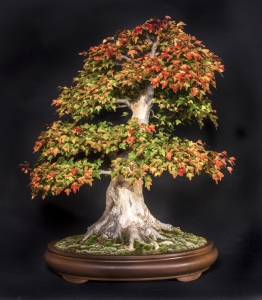The Taskmaster (aka Chris Ross) explains what to do, how to do it and why for bonsaists in the San Francisco Bay Area.
JanFebMarAprMayJunJulAugSepOctNovDec
September
The Autumn is in the air when September and October roll around–if you live somewhere other than the San Francisco bay area microclimates. Oh, the nights begin to seem a bit longer and maybe cooler, but usually only just a bit. The wind can be unpredictable, and chilly nights and cool mornings can give way to really hot afternoons. Hard to keep up with, really. These months offer a bonsai gardener some opportunities and some challenges.
 In September, trees can still be trimmed, wired, and shaped, and we can expect the soil and roots to stay warm and active enough so that some fairly active growth will continue into November. This not a great time to wire deciduous trees. The hardened-off deciduous growth of Summer can be trimmed, and some twiggy divisions may still have time to occur, and the all of it can best be wired when the leaves begin to fail or fall. When the chlorophyll is gone most of the feeding cycle stops, so the leaves can even be removed a little early. This allows you to see the true shape of the tree and makes it easier to wire. For about two weeks after most of the leaves fall off, the trees are flexible, and can be bent. After that, dormancy makes the trees brittle. Wire applied at this time can stay on for a long time, until bud swell usually, because growth slows down so much. But all the conifers, junipers and evergreens can be wired.
In September, trees can still be trimmed, wired, and shaped, and we can expect the soil and roots to stay warm and active enough so that some fairly active growth will continue into November. This not a great time to wire deciduous trees. The hardened-off deciduous growth of Summer can be trimmed, and some twiggy divisions may still have time to occur, and the all of it can best be wired when the leaves begin to fail or fall. When the chlorophyll is gone most of the feeding cycle stops, so the leaves can even be removed a little early. This allows you to see the true shape of the tree and makes it easier to wire. For about two weeks after most of the leaves fall off, the trees are flexible, and can be bent. After that, dormancy makes the trees brittle. Wire applied at this time can stay on for a long time, until bud swell usually, because growth slows down so much. But all the conifers, junipers and evergreens can be wired.
Lots of trees can still be repotted up to early October because the roots can be expected to recover before Winter shuts down growth. Any fruiting or flowering tree suspected or known to have gall in the roots should definitely be repotted in Fall, which discourages the gall. Other trees of these types can be repotted if there are serious concerns about bad drainage over Winter, but it can cause fruit and flower buds to fail next Spring. The tradeoff for a safe Winter and a healthier tree in the long run can make it well worthwhile.
By October all the wisterias, tamarisk, deep cascade pots and others that needed to be kept in a water bath for the hot months should be taken out of the water to sit on the bench and normalize for the Winter. Black pines can have their older needles pulled to slow down growth in the vicinity and to let light and air into the tree during Winter. Summer buds should be plucked back to just two where three are growing, and back to three where four or more showed up. Pines are a deep subject, and every tree is different. Good advice can be found in the book PINES, by Stone Lantern Press as well as on the Bonsai Bark newsletter online and in the archives of the Bonsai Tonight blog by Jonas Depuich. White and five needle pines are best worked on in November.
Watch out for trees whose drainage is slowing down and mark them for special care regarding water until repotting can be done. Summer growth of trees, especially in smaller pots, will fill the pot with roots as surely as they filled the air with leaves, and failure to thrive, dying twigs or branches, or root rot are likely to be next.
Watch out for warm wind or hot afternoons that might scald and damage leaves or even next Spring’s buds.
Watch out for bugs, and militate with vigor against their comfort and success.
Watch out for moss climbing on the bark and exposed roots, which will rot and spoil the base of the trees. Spray it with alcohol, then brush it gently off when it has thoroughly dried out.
Watch out for harvest moons, for Autumn constellations in the sky, for the ponderous mystery of the slow roll of the seasons into a new reality.
And watch out for signs of love in your life, of closeness and connectedness to each other, and to all our fellow creatures great and small with whom we live and move and have our being.
– The Taskmaster

